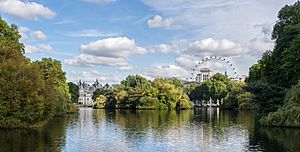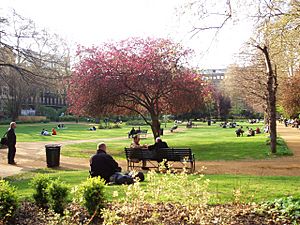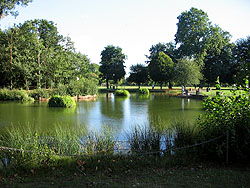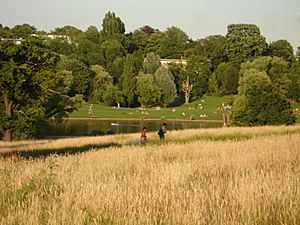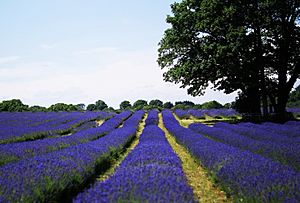Parks and open spaces in London facts for kids
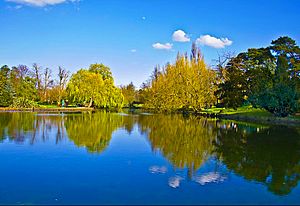
London is famous for its many green spaces, which are like the city's lungs! These include huge parks, smaller garden squares, and even wilder areas. About 40% of London is public green space, with over 3,000 parks covering a massive 35,000 acres (about 14,164 hectares). These green areas are super important for nature, fresh air, and for people to relax and play.
Contents
London's Royal Parks
The most famous green spaces in London are the eight Royal Parks of London. These parks used to be hunting grounds for kings and queens, but now they are open for everyone to enjoy. Together, they cover a huge area of 1,976 hectares (4,882 acres)!
Here are the eight Royal Parks and their sizes:
- Richmond Park 955 hectares (2,360 acres)
- Bushy Park 445 hectares (1,100 acres)
- Regent's Park 166 hectares (410 acres)
- Hyde Park 140 hectares (350 acres)
- Kensington Gardens 107 hectares (260 acres)
- Greenwich Park 74 hectares (180 acres)
- St James's Park 23 hectares (57 acres)
- Green Park 16 hectares (40 acres)
Garden Squares: Hidden Green Gems
In central London, you'll find many smaller green spots called garden squares. These were originally built for the people living in fancy houses nearby. While some are still private, many are now open to the public. Great examples you can visit include Russell Square in Bloomsbury, Lincoln's Inn Fields in Holborn, and Soho Square in Soho.
The Royal Borough of Kensington and Chelsea has over a hundred garden squares. Most of these are just for the people who live in that area. The money to keep these beautiful spaces tidy often comes from a special fee added to the residents' local taxes.
Council Parks: Parks for Everyone
Besides the Royal Parks, many other parks are looked after by London's local councils. These parks were mostly created between the mid-1800s and the Second World War.
Here are some examples of these council-run parks:
- Victoria Park in the London Borough of Tower Hamlets is 86.18 hectares (213 acres).
- Battersea Park in the London Borough of Wandsworth is 83 hectares (205 acres).
- Beckenham Place Park in the London Borough of Lewisham is 96 hectares.
- Crystal Palace Park in South London is 80 hectares (200 acres).
- Brockwell Park in Lambeth Council is 51 hectares (126 acres).
- Alexandra Park in the London Borough of Haringey is 80 hectares (197.68 acres).
* Some parks in Tottenham, also in Haringey, include Bruce Castle park (the oldest in Tottenham), Lordship Recreation Ground, and Downhills Park.
- Grosvenor Square in the City of Westminster is another well-known green space.
Other Amazing Green Spaces
London also has many other large open spaces, especially in the outer parts of the city. These areas often feel more natural, like the countryside, because they were protected as the city grew around them.
Some of these larger green spaces include:
- Thames Chase (9,842 hectares / 24,320 acres)
- Epping Forest (2,476 hectares / 6,118 acres)
- Wimbledon Common (460 hectares / 1,136 acres)
- Hampstead Heath (320 hectares / 790 acres)
- Walthamstow Wetlands (211 hectares / 520 acres)
- Mitcham Common (182 hectares / 450 acres)
- Trent Park (169 hectares / 418 acres)
- Hainault Forest Country Park (136 hectares / 336 acres)
- Clapham Common (89 hectares / 220 acres)
- Wormwood Scrubs (80 hectares / 200 acres)
- Wandsworth Common (73 hectares / 180 acres)
- Gunnersbury Park (72 hectares / 178 acres)
- Tooting Bec Common (62 hectares / 152 acres)
Even some cemeteries, like Highgate Cemetery, offer large green areas within the city. London also has famous gardens you can visit, such as the Royal Botanic Garden at Kew and the beautiful gardens at Hampton Court Palace.
London's Lavender Fields
Did you know London has lavender fields? In the London Borough of Sutton, there are two historic lavender fields. One, at Oaks Way, Carshalton Beeches, is run by the community. The other, a 25-acre commercial farm called Mayfield in Croydon Lane, is very popular with visitors. This area was once known as the "Lavender Capital of the World" because the soil is perfect for growing lavender!
Greenways: Paths Through Nature
London also has special paths called London greenways. These are routes that connect different green spaces, often following old railway lines or canals. Examples include The Greenway and the Thames Path, which follows the River Thames.
London: The World's First National Park City
In July 2019, London was officially named the world's first National Park City. This is a special title that means London is a large urban area that works to protect and improve its natural environment. It's not the same as a traditional National Park, but it shares the same goal of making nature a bigger part of city life.
This idea is led by volunteers and supported by local councils and the Mayor of London. The National Park City Foundation hopes to inspire 25 more National Park Cities around the world by 2025.
See also


